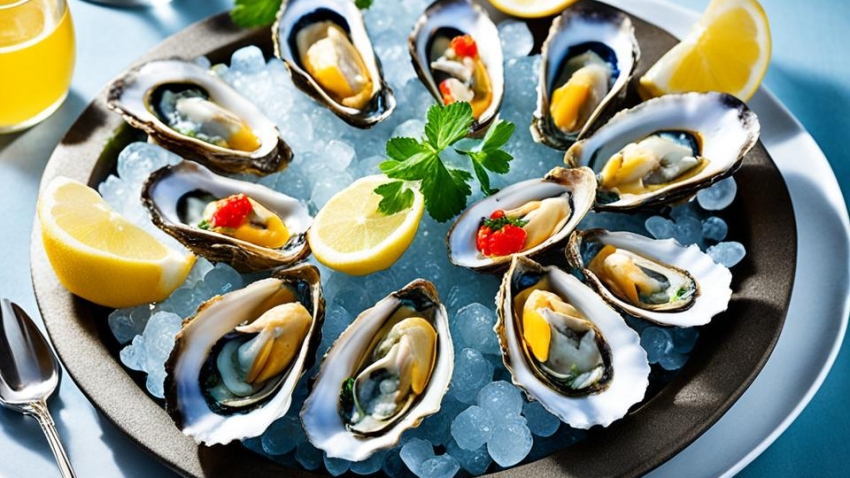
Oyster & Mussel: Delicious Seafood Delicacies
Oysters and mussels have been a big deal in the culinary world for a long time. These seafood treats are known for their unique tastes and textures. They’re often linked with fine dining, coastal foods, and even being seen as aphrodisiacs. We’re going to dive deep into the world of oysters and mussels. We’ll look at their health benefits, how they’re farmed sustainably, and their many uses in cooking and culture worldwide.
Read interesting things at : revolutionbookscamb
Key Takeaways
- Oysters and mussels are nutritious bivalve mollusks that offer a wide range of health benefits.
- Sustainable aquaculture practices have made oyster and mussel farming an environmentally-friendly industry.
- Oysters and mussels are versatile ingredients used in a variety of raw and cooked dishes, from raw bars to gourmet cuisine.
- The purported aphrodisiac properties of oysters have captivated the public’s imagination for centuries.
- Pearls, a natural byproduct of oysters, have long been prized as precious gems.
The Bivalve Wonders: Oyster & Mussel
Oysters and mussels are amazing bivalve mollusks. They have two-part hinged shells. These aquatic creatures are loved for their taste, texture, and health benefits. They are key ingredients in many cuisines around the world.
Oysters and mussels are part of the shellfish family. They are versatile and fit well in many dishes. People enjoy them raw or cooked, making them a favorite for centuries.
| Oysters | Mussels |
|---|---|
| Typically have a cupped, irregular shell | Generally have a smooth, elongated shell |
| Found in both saltwater and brackish environments | Predominantly found in saltwater habitats |
| Known for their diverse flavors, ranging from briny to creamy | Offer a distinctive, slightly sweet and nutty taste |
Oysters and mussels are more than just food. They are crucial for the health of marine life and aquatic creatures. They help keep the ocean balanced by filtering water and supporting the ecosystem.
“Oysters and mussels are the unsung heroes of the sea, providing us with delectable flavors while also playing a crucial role in sustaining the delicate balance of our oceans.”
We will learn more about oysters and mussels soon. We’ll see their health benefits, sustainable farming, and how they are loved in many cultures.
Nutritional Benefits of Oysters and Mussels
Oysters and mussels are packed with vitamins, minerals, and high-quality protein. They are great for your health and should be part of a balanced diet.
Protein-Rich Powerhouses
Oysters and mussels are full of protein, which is key for muscle health. Protein helps with repairing tissues and supporting the immune system.
Essential Minerals and Vitamins
These foods are also loaded with minerals like zinc, iron, and selenium. These minerals are important for staying healthy. They help with the immune system, skin, and hair health. Plus, they’re full of vitamin B12 and vitamin C. These vitamins boost energy and help fight off sickness.
| Nutrient | Oysters (100g) | Mussels (100g) |
|---|---|---|
| Protein (g) | 9.5 | 7.0 |
| Zinc (mg) | 16.6 | 0.5 |
| Iron (mg) | 3.7 | 1.9 |
| Selenium (μg) | 55.2 | 20.5 |
| Vitamin B12 (μg) | 16.1 | 8.2 |
| Vitamin C (mg) | 5.9 | 2.5 |
Adding oysters and mussels to your meals can bring many health benefits. They help with muscle growth, repair, and overall wellness.
Oyster & Mussel Farming: Sustainable Aquaculture
The farming of oysters and mussels through sustainable aquaculture is key to meeting the world’s growing demand for these tasty seafood. Techniques like bottom and suspended culture help produce oysters and mussels in a way that’s good for the planet. This supports conservation and keeps these bivalves in our plates.
Aquaculture farming is a smart choice, offering an alternative to wild-caught seafood that can harm the environment. By managing the growth and harvest of oysters and mussels, farmers can keep providing us with eco-friendly seafood in a responsible way.
Bivalve cultivation has a low environmental impact. Oysters and mussels eat phytoplankton and other organic stuff, cleaning the water. This helps the ocean and makes the oysters and mussels taste better.
“Sustainable aquaculture is crucial for meeting the growing global demand for seafood while preserving our marine ecosystems.”
Methods like suspended and off-bottom culture make it easy and safe to grow oysters and mussels. This way, we get a steady supply of these tasty bivalves without harming their homes. It’s good for the industry and the planet.
As we want more eco-friendly seafood, sustainable aquaculture will play a bigger role in growing oysters and mussels. By choosing these responsible farming methods, we can enjoy these seafood treats and help protect our oceans.
Culinary Delights: Oysters and Mussels in Cuisine
Oysters and mussels are stars in the kitchen, loved for their versatility. They shine in both raw and cooked dishes. From oysters Rockefeller to mussel bouillabaisse, they make many meals special.
Raw Bar Favorites
Oysters on the half shell are a classic at the raw bar. They offer a burst of briny flavor. Served with sauces and lemon, they’re perfect for impressing guests or enjoying a fancy meal.
Cooked Oyster and Mussel Dishes
Oysters and mussels also excel in cooked dishes. Oysters Rockefeller is a rich, herb-topped dish from New Orleans. Mussel stews, like bouillabaisse, show how versatile these seafood are in cooked dishes.
Chefs love to get creative with oysters and mussels. They use them in everything from grilled dishes to pasta. This keeps the seafood exciting and new.
“Oysters and mussels are the chameleons of the seafood world, able to adapt to a wide range of culinary styles and flavors.” – Chef Julia Langford
Oysters and mussels are favorites worldwide, enjoyed raw or cooked. They bring joy to food lovers everywhere. From the fancy raw bar to hearty cooked meals, these mollusks inspire chefs and home cooks to try new things.
Aphrodisiac Properties: Myth or Reality?
Oysters and mussels are often seen as aphrodisiacs. This idea has sparked debate and interest over time. Even though there’s no clear scientific evidence, people believe they help with sexual health and performance. This has made these mollusks popular and intriguing.
Some believe oysters and mussels boost sexual desire because they’re full of zinc. But scientists don’t all agree on this. Some studies hint at benefits, while others are unsure.
The idea that oysters and mussels are aphrodisiacs goes way back. Ancient Greeks and Romans talked about it. These cultural beliefs have kept these foods popular over the years.
“The power of the aphrodisiac is more in the mind than in the mollusk.” – Dr. Meredith Barratt, Sexologist
The debate on oysters and mussels as aphrodisiacs is ongoing. But they’re loved for more than their possible sexual health perks. They’re known for their great taste, nutritional value, and being good for the planet. This makes them interesting for both science and gastronomy fans.
Pearls: Nature’s Precious Gems from Oysters
Oysters are not just known for their tasty meat but also for the beautiful pearls inside them. The process of pearl cultivation involves putting a foreign object in an oyster to make it produce a pearl. This has led to many different kinds of natural gems, each with its own special look and value.
Pearl Cultivation and Varieties
The art of pearl cultivation has changed a lot over time. Now, we can enjoy many kinds of pearls, from classic oyster pearls to exotic ones. These gemstones come in various colors, shapes, and sizes. Each one has its own charm and beauty.
| Pearl Variety | Characteristics | Origin |
|---|---|---|
| Akoya Pearls | Renowned for their stunning luster and spherical shape, Akoya pearls are the quintessential cultured pearls. | Japan |
| South Sea Pearls | Larger in size and with a rich, creamy luster, South Sea pearls are highly prized for their rarity and beauty. | Philippines, Australia, Indonesia |
| Tahitian Pearls | Characterized by their unique range of captivating colors, from deep black to stunning shades of green and purple, Tahitian pearls are a true natural wonder. | French Polynesia |
The world of pearls is still fascinating and inspiring. Each type offers a special and magical look into nature’s wonders.

Oyster & Mussel Festivals and Events
Oysters and mussels are loved worldwide, leading to many festivals and events. These culinary celebrations let fans dive into the history, taste, and culture of these bivalve mollusks. From Ireland’s Galway International Oyster & Seafood Festival to Japan’s Hama Oyster Festival, there’s something for everyone.
At these festivals and events, you can try many ways to enjoy oysters and mussels. From raw to creative seafood dishes, there’s a lot to taste. You’ll also learn about how they’re farmed and why it’s important to get them from responsible sources.
| Festival | Location | Highlights |
|---|---|---|
| Galway International Oyster & Seafood Festival | Galway, Ireland | Oyster shucking competitions, live music, and seafood-inspired culinary delights |
| Hama Oyster Festival | Hama, Japan | Celebration of the region’s renowned oyster cultivation, featuring traditional preparations and cultural demonstrations |
| Whistable Oyster Festival | Whistable, England | Oyster-themed street food, live entertainment, and a showcase of the local maritime heritage |
These festivals and events show off the best of oysters and mussels. They also teach people about sustainable aquaculture and protecting seafood culture. By going to these events, you’ll learn more about these tasty bivalves and their future.
Responsible Sourcing and Sustainability
The demand for sustainable seafood is rising. This makes it crucial to focus on responsible sourcing and protecting the environment. People want to buy oysters and mussels from places that are good for the planet. This helps keep the oceans healthy for the future.
It’s important to get oysters and mussels from places that manage their resources well. They should follow rules that protect the ocean and keep seafood available for a long time.
| Sustainable Seafood Practices | Benefits |
|---|---|
| Certified Sustainable Aquaculture | Ensures environmentally responsible farming methods, protecting marine habitats and minimizing ecological impact. |
| Traceability and Transparency | Provides consumers with information about the source and production methods of the seafood, enabling informed choices. |
| Responsible Harvesting Techniques | Prioritizes the conservation of wild oyster and mussel populations, preventing overfishing and habitat destruction. |
By choosing sustainable seafood, we can help protect oysters and mussels for the future. This way, we can enjoy these tasty and healthy foods for many years to come.
“Sustainable seafood is not just a trend, but a necessity for the health of our oceans and the enjoyment of these marine delicacies.”
As more people want to eat oysters and mussels, we must source them responsibly. By choosing sustainable options, we help keep these foods available and protect our oceans.
Health Concerns and Precautions
Oysters and mussels are usually safe to eat, but it’s important to know about health issues and take steps to stay safe. Making sure you handle and prepare the food right is key. Also, being careful about allergies is crucial for a good time eating these seafood treats.
Food Safety and Allergies
When it comes to oysters and mussels, food safety is a big deal. These foods can carry harmful germs, viruses, or toxins if not cooked or handled correctly. It’s important to get your seafood from trusted sources and follow the right steps to prepare it. This helps avoid illnesses like Vibrio infections or Norovirus outbreaks.
Some people might be allergic to seafood, which can cause mild to severe reactions. If you’re allergic to shellfish, be extra careful. Talk to your doctor before eating oysters, mussels, or other shellfish.
- Ensure proper food handling and preparation to prevent food safety issues
- Be aware of potential allergies and consult a healthcare professional if you have concerns
- Source seafood from reputable suppliers to minimize health risks
- Follow recommended cooking guidelines to kill any harmful bacteria or toxins

By being careful and aware of health risks, you can enjoy oysters and mussels safely. This way, you get to enjoy their taste and health benefits without worrying about health concerns.
Oyster & Mussel Recipes and Preparation Tips
Exploring the world of oysters and mussels means learning about different ways to prepare them. From raw to cooked dishes, we’ll look at various recipes and techniques. These will help both experts and beginners make amazing seafood dishes.
Do you like oysters raw or cooked? There are many preparation techniques and recipes to try. Let’s discover how to make the most of these tasty seafood treats.
Raw Bar Favorites
- Classic Oysters Rockefeller: Succulent oysters baked with a rich, creamy topping of spinach, cheese, and breadcrumbs.
- Oysters Kilpatrick: Grilled oysters topped with a savory bacon and Worcestershire sauce mixture.
- Chilled Mussels with Mignonette Sauce: Plump mussels served with a tangy, vinegar-based mignonette sauce.
Cooked Oyster and Mussel Dishes
- Creamy Oyster Stew: A comforting dish featuring succulent oysters in a rich, velvety broth.
- Mussel Marinara: Mussels simmered in a zesty tomato sauce, often served with crusty bread for dipping.
- Oyster Po’ Boy Sandwich: Crispy fried oysters nestled in a soft, fluffy roll with all the classic fixings.
Getting the best out of oysters and mussels is all about the right preparation techniques and recipes. Whether you’re new to seafood or a pro, there are endless ways to make tasty seafood dishes.
Oyster & Mussel: A Global Delicacy
Oysters and mussels are loved worldwide, each place adding its own twist to them. From Japan’s Kumamoto oysters to Belgium’s moules-frites, these seafood delicacies show the rich culinary traditions and regional specialties across the globe.
Regional Specialties and Traditions
In the Pacific Northwest, Olympia oysters are known for their delicate taste. The East Coast is famous for its Blue Point oysters, which are plump and juicy. In Ireland, Irish Galway oysters are celebrated for their crisp flavor. The Dutch mussels from Zeeland are loved for their firm texture and sweet taste.
Oysters and mussels have unique culinary traditions around the world. In France, moules-frites is a classic dish. Spain treasures percebes, or goose barnacles. Japan shows the versatility of these mollusks with dishes like Kaki-fry and Kaki Oroshi.
| Region | Specialty | Preparation |
|---|---|---|
| Pacific Northwest, USA | Olympia Oysters | Raw on the half shell |
| East Coast, USA | Blue Point Oysters | Grilled, baked, or fried |
| Ireland | Galway Oysters | Served raw with lemon |
| Netherlands | Dutch Mussels | Steamed in white wine and herbs |
| France | Moules-Frites | Steamed mussels with french fries |
| Spain | Percebes | Boiled and served with garlic sauce |
| Japan | Kaki-fry, Kaki Oroshi | Fried oysters, raw oysters with grated daikon |
Oysters and mussels are loved worldwide for their taste and the culinary traditions around them. From North America to Europe and Asia, these seafood delicacies show the rich regional specialties and global cuisine of the world.
Conclusion
As we wrap up our journey into the world of oysters and mussels, it’s clear they’ve won over many food lovers. Their history, cultural importance, and health benefits make them special. Plus, their sustainable farming is a big plus.
The future looks bright for these sea delicacies. Chefs will keep finding new ways to use oysters and mussels in their dishes. And, efforts to protect these resources will keep them available for years to come.
We can look forward to more people enjoying the unique tastes and health perks of oysters and mussels. There will also be a greater focus on their role in the environment and culture. Every bite reminds us of the ocean’s wonders and the need to protect them.









Leave a Reply